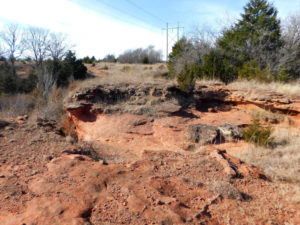 The canyon! Today I lugged my big camera out on the trail at Draper Lake. As we shall see, the weak points on this camera showed today. Two other shots of this small sandstone canyon didn’t turn out at all well. Still, this shows at least some of what you might see. The deep water course cuts through the rock formations here and yields cliffs that are at least as high as I am tall.
The canyon! Today I lugged my big camera out on the trail at Draper Lake. As we shall see, the weak points on this camera showed today. Two other shots of this small sandstone canyon didn’t turn out at all well. Still, this shows at least some of what you might see. The deep water course cuts through the rock formations here and yields cliffs that are at least as high as I am tall.
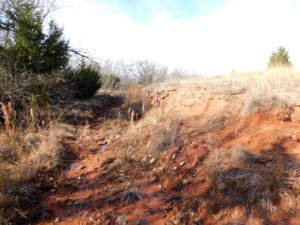 I was able to ride most of the way. I started down the west side of the point. At this spot, the trail drops down through a rock outcropping, and it happened that this formed a small bowl that held some rain water. It hasn’t rained in days out here, but this pocket was wet and muddy. Most of the route was just damp as I followed the old shore trail along the west side of the point.
I was able to ride most of the way. I started down the west side of the point. At this spot, the trail drops down through a rock outcropping, and it happened that this formed a small bowl that held some rain water. It hasn’t rained in days out here, but this pocket was wet and muddy. Most of the route was just damp as I followed the old shore trail along the west side of the point.
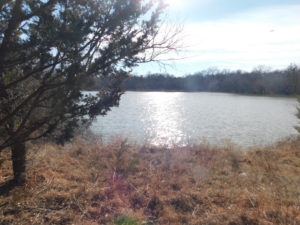 This image shows a major flaw in the camera. The lens is not dirty; the camera doesn’t handle sunlight very well. It creates a lot of ghosts and other artifacts that spoil the shot. This was a view from one of the grassy places along the trail, shot across the cove between Points 6 & 7. There is no place to attach any kind of external filter to the lens, so I just have to remember not to point it toward the sun. That means missing a lot of shots. This is actually one of the better ones.
This image shows a major flaw in the camera. The lens is not dirty; the camera doesn’t handle sunlight very well. It creates a lot of ghosts and other artifacts that spoil the shot. This was a view from one of the grassy places along the trail, shot across the cove between Points 6 & 7. There is no place to attach any kind of external filter to the lens, so I just have to remember not to point it toward the sun. That means missing a lot of shots. This is actually one of the better ones.
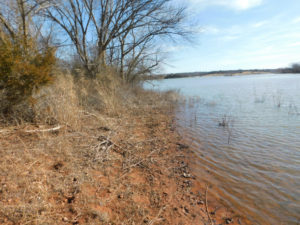 Most of the shore in the area of Point 7 is either a dirt bluff or it slopes down to a swampy area like this. Keep in mind that the water level is at least 3 feet (1m) higher than normal, but it’s almost like this even at low water. Most of the large bedrock shelves are way up out of the water, so this is one of the easiest points to approach in a boat, but then it’s almost impossible to climb out. There is thick vegetation growing right into the water in most places.
Most of the shore in the area of Point 7 is either a dirt bluff or it slopes down to a swampy area like this. Keep in mind that the water level is at least 3 feet (1m) higher than normal, but it’s almost like this even at low water. Most of the large bedrock shelves are way up out of the water, so this is one of the easiest points to approach in a boat, but then it’s almost impossible to climb out. There is thick vegetation growing right into the water in most places.
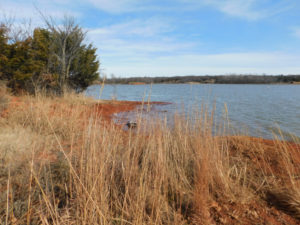 Out on the actual point itself, there is this lovely little cove, if you don’t mind the old tire. There is a huge pile of them dumped up higher on the shore. I spotted soda bottles that haven’t been sold since the 1990s. This must have been a very popular point to drive to back in the day, because the Parks and Recreation crews at some point placed massive stones across the parking area to block four-wheeled vehicles.
Out on the actual point itself, there is this lovely little cove, if you don’t mind the old tire. There is a huge pile of them dumped up higher on the shore. I spotted soda bottles that haven’t been sold since the 1990s. This must have been a very popular point to drive to back in the day, because the Parks and Recreation crews at some point placed massive stones across the parking area to block four-wheeled vehicles.
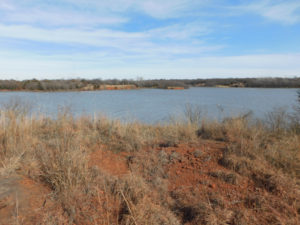 Right behind the point and the makeshift parking area is a little stone ridge. You can get quite a lovely view of the area. In this shot, we are looking eastward across the lake towards Point 8. That entire point has a no-wheels restriction off the road. I haven’t seen much of it, but I suspect it was badly torn up back when off-road bikes were allowed throughout the park. By the way, the camera wasn’t able to show the perspective, because the shore road should be just visible in the lower foreground, but in this shot it looks all the same because of the grass.
Right behind the point and the makeshift parking area is a little stone ridge. You can get quite a lovely view of the area. In this shot, we are looking eastward across the lake towards Point 8. That entire point has a no-wheels restriction off the road. I haven’t seen much of it, but I suspect it was badly torn up back when off-road bikes were allowed throughout the park. By the way, the camera wasn’t able to show the perspective, because the shore road should be just visible in the lower foreground, but in this shot it looks all the same because of the grass.
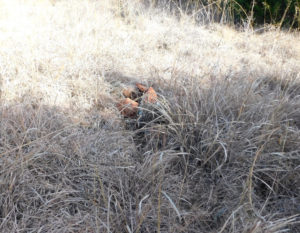 This is all that remains of a memorial that once stood near the start of the trail to the canyon and along the western side of the point. None of my other shots from today’s ride turned out, but I wasn’t going to skip this one. The original memorial is in my image archives on this blog and I’m pulling it up for a repost here for comparison.
This is all that remains of a memorial that once stood near the start of the trail to the canyon and along the western side of the point. None of my other shots from today’s ride turned out, but I wasn’t going to skip this one. The original memorial is in my image archives on this blog and I’m pulling it up for a repost here for comparison.
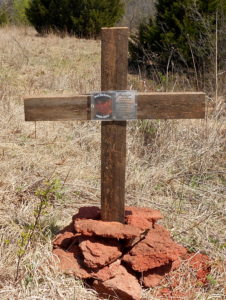 Don McEntire’s body was found out here back in March of 2016. That day I was riding around the lake and saw a huge collection of white pickups and some other vehicles at the head of that trail. At the time I had no idea what it was about, but when I went back later I followed all the tracks in the dirt and found this memorial standing in the grass. The story didn’t get a lot of notice in the press. However, through other channels I heard from the family of the man. They had been searching for him some 6 months at the point; there wasn’t much left of him.
Don McEntire’s body was found out here back in March of 2016. That day I was riding around the lake and saw a huge collection of white pickups and some other vehicles at the head of that trail. At the time I had no idea what it was about, but when I went back later I followed all the tracks in the dirt and found this memorial standing in the grass. The story didn’t get a lot of notice in the press. However, through other channels I heard from the family of the man. They had been searching for him some 6 months at the point; there wasn’t much left of him.
The day started out pretty cool, but by the time I got to the trail, I was already sweating. Turned out to be a warm sunny day at around 60°F.


Such a sad story about the man, but at least they found his remains and were able to create a memorial at the time.
That whole area looks like a good place to find arrowheads. ??
Here’s what I know about native artifacts found in Central Oklahoma. Arrowheads would be made from hard stone. There is none in this area, not for a hundred miles. The few native artifacts we find in Central Oklahoma are bits of woven stuff and sticks that somehow get buried where they don’t rot. Mostly all we find in this area are bones, ash pits and the subtle presence of wood posts that rotted well below the surface and changed the composition of the soil.